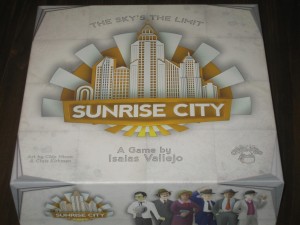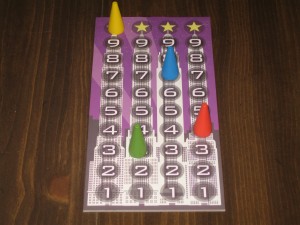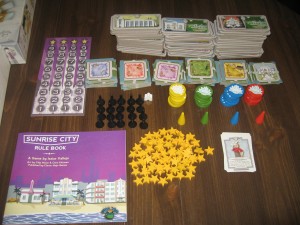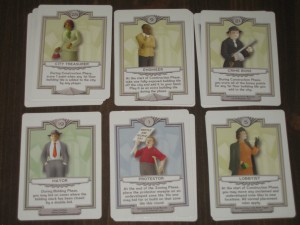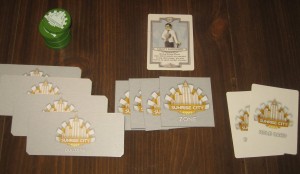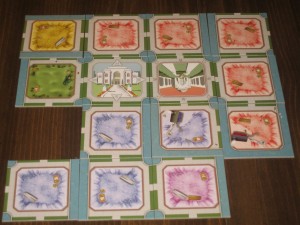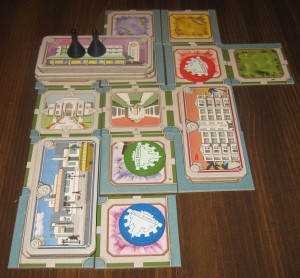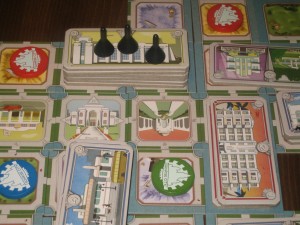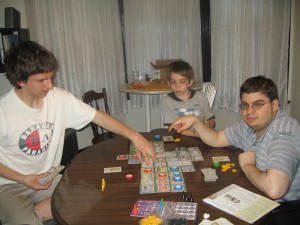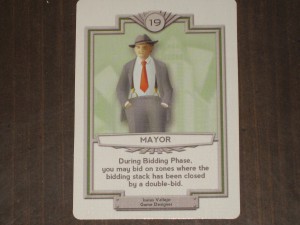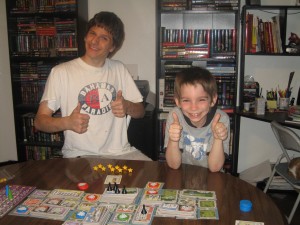Words can’t express how psyched I was when I discovered this game. I am a big fan of city builder games and a lot of the good ones that people recommended to me are either out of print or go for outrageous amounts on Amazon or eBay. Sure, you could play SimCity 4 or Cities XL on the PC…but the former was released in 2003 and the latter I didn’t find to be all that good. I desperately needed to scratch that city builder itch, and Sunrise City happened to come along just in the nick of time.
Before we begin looking at the components, setup, gameplay, and the review, I would like to extend a quick thank you to David MacKenzie from Clever Mojo Games for sending me a free copy to review.
Objective
The object of the game is to have the most benchmark tokens by the end of the game’s three rounds. Players earn benchmark tokens by getting their score marker to the very top of the scoreboard. If players manage to get the exact number of points needed to reach the top, they earn two benchmark tokens. If they earn MORE points than needed to reach the top, the score marker wraps around back to the bottom of the scoreboard and players only earn one benchmark token.
Components
Bid Markers – Each player gets six bid markers of their color, which they will use to try to take control of undeveloped zones.
Zone Tiles – These square-shaped tiles come in many different colors, which represent the type of zone they are. Red = Residential, Blue = Commercial, Yellow = Industrial, Green = Parks, and Purple = Mixed Use. People who have played SimCity before will feel right at home with these color schemes. Zones also have borders that are either blue (waterway) or gray (sidewalks)…more on that in a bit.
Community Tiles – These square-shaped tiles represent a building that provides a bonus to surrounding zone tiles.
Building Tiles – These rectangular shaped tiles fit across two zone tiles and come in various color combinations. The colors are the same as the zone tiles…that is…Red for Residential, Blue for Commercial, etc.
City Hall Tile – This square-shaped tile serves as the center of your city and is placed during setup.
Floor Markers – Players earn “floor points” for every odd-numbered floor they build. These black, cone-shaped markers are placed on buildings with even-numbered floors to help remind players that they’ll score points should they continue placing floors on that building.
Role Cards – Role cards determine who will be the first player for a round, as well as provide players with the use of special abilities.
Meeple – There is one protester meeple that comes into play when someone uses the special ability on the Protester role card.
Scoreboard – This scoring track allows players to see how close they are to earning either one or two benchmark tokens, depending on whether or not they land directly on the “star” at the top or pass it by.
Benchmark Tokens – The player with the most of these yellow, star-shaped tokens wins the game.
Setup
Setting up the game is fairly quick and comprises of the following:
1. Each player chooses a color and gets six bid markers of their color.
2. The City Hall tile is placed in the center of the table.
3. Shuffle the building and zone tiles and place them face down into stacks, separately. Community tiles are shuffled in with the zone tiles.
4. Place the scoreboard off to the side and place the scoring markers of the appropriate colors nearby.
5. Shuffle the role cards and deal four to each player. Each player selects a role card and puts it face down on the table and passes their remaining cards off to their left. Players keep choosing a card and passing until everyone has three facedown role cards. The unused role cards are placed back into the box.
Gameplay
The game consists of three rounds, each of which has four phases.
Phase One: Preparation
Each player will draw four building tiles and four zone tiles, which will make up their hand. Players will then choose one of their role cards and place it face down. When everyone has chosen a role card, they reveal them all at once and the person with the lowest numbered role card goes first in all phases during the current round.
Phase Two: Zoning
The first player (as determined by the role card in phase one) begins by placing a zone tile next to the City Hall tile. Players continue clockwise, adding zone tiles next to existing ones until all zone tiles have been played from their hand. Should a player place a community tile, they get to draw a new zone tile and immediately place it. The borders of at least one adjacent zone tile must be gray-to-gray in order for the placement to be legal.
In rounds two and three, the first player will choose a direction either north, south, east, or west of the City Hall and ALL players must place their zone tiles in that direction of the city. This is to prevent players from creating their own “mini-cities” separate from everyone else.
Players can score points this round by creating districts. A district is formed when two zones of the same color become adjacent to one another. Players earn one point for each adjacent, same colored, matching tile that is next to the one that they just placed.
Phase Three: Bidding
After all of the players have placed their zone tiles, the bidding phase begins. Starting with the first player, going clockwise, players will be placing bid markers on undeveloped zone tiles. Each player places one bid marker at a time.
Players can “outbid” an opponent by placing a bet token on top of the existing bet…whoever has the topmost bid token wins that zone, regardless of how many bets other players might have on it.
If a player manages to place two of their bid tokens on top of each other, in a row, the bet becomes locked and they win that property automatically.
The winning bets stay on the property and all of the losing bets are returned to their owners.
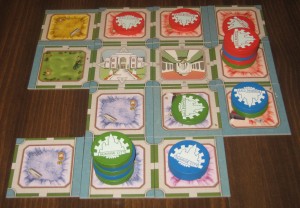
Players must own at least one zone where they intend to construct a building, so do your best to claim the zones that compliment the buildings in your hand.
Phase Four: Construction
Finally, players will be placing building tiles on top of zone tiles or existing building tiles, starting with the first player.
In order for the first floor building placement to be legal:
1. The colors on the buildings must match the colors of the zone tiles. The exception to that rule are zones and buildings that are purple in color (mixed use)…they serve as sort of a wild card and can be stacked with any other color.
2. Players must have at least one bid token on the zone they are trying to place a building on.
3. The two zones in question must have sidewalk-to-sidewalk (gray-to-gray) adjacency.
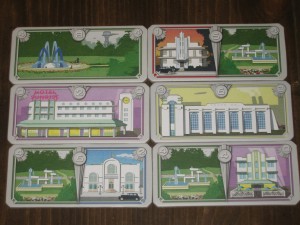
Building tiles come in all sorts of different flavors. Purple colors don’t score that much, but allow for flexible building placement.
The player who places the building earns the points listed in the top center of the building tile. Bonus points are awarded to those who own the zone tiles that the building is placed on…you can find those bonus points listed on the building tile’s top corners, closest to the edge.
In regards to legal placement of a building tile on an existing building:
1. You can cross / connect other buildings, assuming that the existing building tiles are on the same level.
2. The existing building colors must match the new building colors, with the exception of purple’s “wild card” mechanic.
The player placing the building tile in this fashion only earns the main points listed on the building tile…the bonus points are ignored. Players earn additional points as they complete odd-numbered floors. The third floor grants one point, the fifth floor grants two points, the seventh floor grants three points, and etc. Floor markers are used on even-numbered floors to help remind players that they could score by building upon it.
Community points are also awarded as new building tiles of the appropriate color are placed around it (in all eight surrounding squares). This goes for the first building tile and all building tiles stacked on top of it. Players earn one point per matched tile with a total possible two points per placement.
After all of the players have placed their building tiles, the round ends and a new one begins, starting with phase one. If this was round three, the game is over and the person with the most benchmark tokens wins!
I realize that I didn’t cover every little detail found in the manual, but the above should give readers an idea of what they are in for.
The Review
First of all, the components are top-notch. I couldn’t believe how thick the building tiles were. It’s clearly obvious how much work and money went into these components. The zone and building tiles are eye-catching and the bid markers clearly stand out, making it easy to identify who owns what zones. I also wanted to note that the game came with some extra zip baggies…this always scores bonus points with me. Great job with the components all around!
I found the replay value to be extremely high due to a number of reasons. For one, the role cards will change your strategy a bit in regards to how you will place tiles and score points. Since you have three rounds and three role cards, playing the right ones at the right times will be important. The way a city can expand in different directions in every game help to keep things fresh and new with each and every game. I can’t imagine becoming bored with this game…there’s just too many ways the game can play out.
Likewise, players will always have a few choices in regards to playing strategically. The scoreboard and the “land on the star for two benchmark tokens” mechanic forces players to not only score points, but do it in the most efficient manner possible. While you’ll most likely be placing zones in a way that compliment the buildings in your hand, you’ll also be keeping an eye on what zones could be potential hot spots during the construction phase so that you can snatch them up in the bidding phase. As I mentioned already, role cards will help compliment a particular strategy.
Just as an example, the Banker role card allows a player to re-use their returned bid tokens to get unclaimed zones. You could, in theory, engage your opponent in an intense bidding war over one particular zone, forcing them to spend all of their bids on one or two locations. You could then get your bids back and claim a bunch that are still available.
Anthony Jr, the sixteen year old, liked how the city started from one tile and expanded into a full-fledged city by the end of the game. I have to admit that I too, enjoyed watching the progression of the city’s growth. Vincent Jr, the eleven year old, enjoyed placing zones and constructing buildings. I could tell that he was really giving thought to how best to place the buildings in his hand so that he could earn just enough points to reach the star on the scoring track. Both of them really liked the game and expressed an interest in playing it again.
I highly recommend this game to players of all ages. It would appeal the most to city builder enthusiasts who enjoy visually seeing the fruits of their labor, though it would work just as well as a semi-casual board game to play on family fun night.
Final Verdict: 8/10
—
Currently (as of 5/19/12), you can pre-order the game from the publisher’s website here:
You can also find out more information about the game on Kickstarter and Board Game Geek here:
Sunrise City – Board Game Geek
The game is estimated to be released around June 2012.
—

